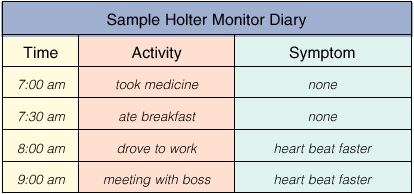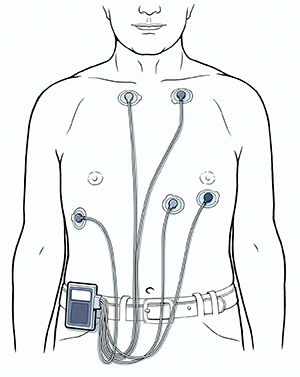What Is Holter Monitoring?
What Is Holter Monitoring?
Holter monitoring is a painless way to record your heartbeat away from your healthcare provider’s office. It is a small, battery-operated electrocardiogram (ECG) machine. It has wires that are put on your chest and a device to carry with you. It is about the size of a small digital camera. Holter monitoring records your heartbeat for at least 24 hours. Your provider then reviews the information at a later time. You can get your Holter monitor at a hospital, test center, or provider’s office.
The monitor is used to record any problems with your heartbeat. It can show racing heartbeats, skipping heartbeats, fluttering heartbeats (palpitations), and fainting. All of these symptoms may be caused by an irregular heartbeat (arrhythmia).
Your Holter monitor
When you get a Holter monitor, your healthcare provider puts small pads (electrodes) on your chest. These connect to the monitor. The monitor attaches to a belt or shoulder strap. You need to keep the device on for at least 24 to 48 hours. You also need to complete a diary. Your provider will tell you how to do so. While wearing the monitor, follow these tips:
Try to sleep on your back.
Don’t take a shower. A sponge bath is OK.
Follow your normal routine. Go to work and exercise as usual. It is important to record your heartbeat during your normal activities.
If an electrode falls off or the unit makes noise, call your healthcare provider. Or call the phone number for device support to see what you should do.
When the monitoring period is over, you will return to your provider's office or an electrocardiogram center. They will look at the information recorded. Make sure you know where to return your device.
It may take a week or so for the information to be looked at. Ask your provider if you should have a follow-up appointment or how you will get the results from your test.
When using a Holter monitor
Stay away from electric blankets, magnets, metal detectors, and high-voltage areas such as power lines. They may affect the recording. Also don’t use machines with large motors or that cause vibrations. These also can affect the recording.
Keeping a Holter monitor diary
Keep a diary of things you do during the day. This is important. It could help you match your symptoms to times when your heart is beating abnormally.
Write down when you take medicines, drive to work, take a nap, or feel stress.
Record the time of day for each entry you make.
Note any changes in activity, including when you take medicines.
Note any symptoms you feel. These might be fluttering heartbeats or skipped beats.
Turn on the monitor as instructed when you feel any unusual symptoms.
When to call your healthcare provider
Call your provider right away if any of these occur:
Dizziness or lightheadedness
Chest pain
Shortness of breath
Strong fluttering heartbeats
Updated:
June 17, 2017
Sources:
ACC/AHA guidelines for ambulatory electrocardiography. Crawford MH. J Am Coll Cardiol. 1999;34(9):912-48., Ambulatory ECG Monitoring. UpToDate.
Reviewed By:
Cunningham, Louise, RN,Gandelman, Glenn, MD, MPH,Snyder, Mandy, APRN


